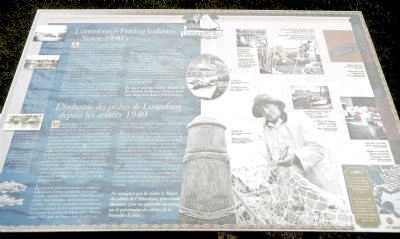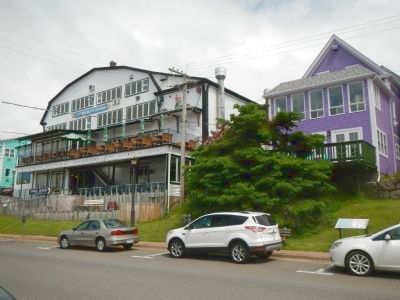Lunenburg in Lunenburg County, Nova Scotia — The Atlantic Provinces (North America)
Lunenburg’s Fishing Industry Since 1940’s
L’industrie des pêches de Lunenburg depuis les années 1940

Photographed By Barry Swackhamer, June 16, 2014
1. Lunenburg’s Fishing Industry Since 1940’s Marker
Captions (English / French): (left side, top to bottom) View of Lunenburg waterfront. / Vue des quais de Lunenburg.; This famous view of the Lunenburg Waterfront graced the back of the Canadian $100 bill for many years. Shown from left to right, Lilla B. Boutileir, E.P. Thenault, and Theresa E. Connor. / Cette scene célébre des quais de Lunenburg à le revers du billet de 100 dollars canadiens pendant de nombreuse années. De gauche à droite: Lilla B. Boutileir, E.P. Thenault, and Theresa E. Connor.; Two stern trailers on the Lunenburg waterfront load salt fish bound for Portugal. Salt fish is no longer loaded on Lunenburg docks.
/ Deux chalutiers arrivée à Lunenburg embarcation du poisson salé à destination du Portugal. On n’embarque plus de poisson salé sur les quais de Lunenburg; (left side, clockwise from the top) Dories stacked on dock of Lunenburg schooner Henry W. Adams c. 1960. / Doris empilés sur le pons du Henry W. Adams, goélette de Lunenburg, vers 1960.; Inshore scallop rakes. / Ratean pour la pêche du pétoncle côtier.; Lunenburg schooner Henry W. Adams, c. 1960. / Le Henry W. Adams, goélette de Lunenburg, vers 1960.; Trawl tubs on the wharf. / Baquets sur le quai dans lesquels sons ramassées les palangres enureulées.; Mending nets. / Réparation des filets.; Cutting fish. / Tranchage du poisson.; Packing fish fillets, Lunenburg Sea Products, 1941. / Empaquetage des filets de poisson, Lunenburg Sea Products, 1941.
Although efforts were made to use large vessels known as otter trawls in the offshore fishery in the 1920’s, they were not used extensively until after the Second World War. Unlike the long line which used baited hooks to attract the fish, otter trawls were dragged along the ocean floor taking everything in their wake. The auxiliary schooners which tended to be privately owned, were soon replaced by side trawlers and draggers owned by large fishing companies like Lunenburg’s High Liner Foods Incorporated. A wider variety of ground fish could now be taken and processed in large fish facilities such as the High Liner Food plant, one of the largest in the world.
The work of offshore fishermen changed dramatically during this period. No longer was it necessary to fish from dories using baited hooks. While fishermen were once considered “co-adventurers” with the vessel’s owners, with the consolidation of the industry, many became salaried employees. In the 1970’s, after a long struggle, offshore fishermen won the right to bargain collectively with the companies.
By the 1990’s, ground fish stocks had declined dramatically resulting in the reduction of the size of Lunenburg’s offshore fleet. Where once “cod was king,” scallops now reign as the most important species caught by Lunenburg-based vessels. Lunenburg is still one of Nova Scotia’s most important fishing communities and this long tradition is celebrated at the annual Fishermen’s Reunion and Picnic, in the exhibits and fishing vessels at the Fisheries Museum of the Atlantic, and along Lunenburg’s historic waterfront of colourful commercial buildings and working fishing vessels.
Be sure to visit the Fisheries Museum of the Atlantic on Bluenose Drive to learn more about Nova Scotia’s fishing heritage.
French
Malgré les efforts déployés dans les années 1920 pour employer de grands bateaux équipés de chaluts à panneaux dans la pêche hauturière, ce n’est qu’après la Deuxième Guerre mondiale que leur usage devient répandu. Contrairement à la pêche à la palangre qui consiste à meuiller des hameçons appâtes pour attirer le poisson, les chaluts à panneaux raclent le fond de la mer et prennent tout sur leur passage. Les goélettes motorisées, qui appartiennent en général à des intérêts prives, sont bientôt remplacées par les chalutiers et dragueurs à pêche latérale des grandes entreprises de pêche comme High Liner Foods Incorporated de Lunenburg. Une plus grande variété de poissons de fond peut désormais être capturée puis transformée dans les grandes usines comme celle de High Liner Foods, l’une des plus grandes au monde.
Le travail des pêcheurs hauturiers se transforme radicalement durant cette période. Il n’est plus nécessaire de pêcher dans de doris à l’aide d’hameçon appâtes. Alors qu’auparavant les pêcheurs étaient considérés comme les «partenaires» de propriétaires des navires, par suite de la consolidation de l’industrie, bon nombre deviennent de simples salariés. Dans les années 1970, après un longue lutte, les pêcheurs côtiers obtiennent le droit de négocier collectivement avec les companies.
Dans les années 1990, l’importante diminution des stocks de poissons de fond entraine le réduction du nombre de navires de pêche hauturière de Lunenburg. Le pétoncle supplante la morue, qui était reine, comme la plus importante espèce capturée par les bateaux basés à Lunenburg. La ville demeure l’une des plus importantes communautés des pêche de la Nouvelle-Écosse. Cette tradition de longue date est célébrée dans le cadre de la réunion et du piquenique annuel des pêcheurs ainsi que par l’entremise de expositions et des bateaux de pêche du Musée de pêches de l’Atlantique et des quais historiques de la ville bordés de bâtiments commerciaux de couleurs éclatantes et de bateaux de pêche toujours en service.
Ne manquez pas de visiter le Musée des pêches de l’Atlantique, promenade Bluenose, pour en apprendre davantage sur la patrimoine de pêches de la Nouvelle-Écosse.
Erected by Town of Lunenburg.
Topics. This historical marker is listed in these topic lists: Industry & Commerce • Waterways & Vessels. A significant historical year for this entry is 1920.
Location. 44° 22.57′ N, 64° 18.65′ W. Marker is in Lunenburg, Nova Scotia, in Lunenburg County. Marker is on Bluenose Drive close to King Street, on the right when traveling west. Touch for map. Marker is at or near this postal address: 67 Bluenose Drive, Lunenburg NS B0J, Canada. Touch for directions.
Other nearby markers. At least 8 other markers are within walking distance of this marker. Lunenburg’s Fishing Industry 1870’s - 1940’s (within shouting distance of this marker); Old Town Lunenburg Historic District (within shouting distance of this marker); The Labrador Whaler Anderson Bros. (within shouting distance of this marker); Lunenburg - Home of the Bluenose & Bluenose II (within shouting distance of this marker); “…for those in peril on the sea.” (within shouting distance of this marker); Lunenburg’s Fishing Industry to the 1870’s (about 150 meters away, measured in a direct line); Rum Running (about 150 meters away); The Fire / Le Feu (about 210 meters away). Touch for a list and map of all markers in Lunenburg.
Credits. This page was last revised on June 16, 2016. It was originally submitted on October 22, 2014, by Barry Swackhamer of Brentwood, California. This page has been viewed 562 times since then and 37 times this year. Photos: 1, 2. submitted on October 22, 2014, by Barry Swackhamer of Brentwood, California. • Andrew Ruppenstein was the editor who published this page.
